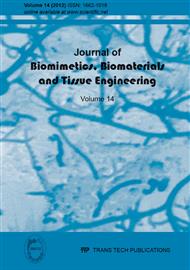p.1
p.31
p.43
p.53
p.65
p.75
p.81
p.93
Interaction of Yeast Cells with Nanoparticles - an FTIR Study
Abstract:
In the present work, samples were prepared allowing yeast to grow simply on YPDA-agar medium at a particular incubation temperature using streaking procedure. Doped specimens of yeast were prepared using YPDA-agar medium in presence of ZnO and TiO2 nanoparticles in a nutrient medium for yeast. ZnO and TiO2 nanoparticles for delivery over yeast cell were prepared with Gum Arabica and Ethanol (CH3CH2OH) respectively as capping agent. Specimens were also developed by laser irradiation on the ZnO doped nanoclusters and pure yeast. FTIR spectroscopy was employed to investigate the effects of nanoclusters and laser irradiation over yeast cell under different conditions. Application of laser irradiation exhibits some positive effect on pure yeast. Effect of ZnO and TiO2 nanocluster doping on yeast are found to be toxic over Yeast Amide in general. Laser irradiation on nanocluster doped yeast cell enhanced the toxicity of nanoclusters. The later part of this study confirms the destruction of Amides in yeast. This preliminary work is an in-vivo application of drug delivery principle using ZnO nanocluster in Gum Arabica background.
Info:
Periodical:
Pages:
65-73
Citation:
Online since:
July 2012
Authors:
Keywords:
Price:
Сopyright:
© 2012 Trans Tech Publications Ltd. All Rights Reserved
Share:
Citation:


